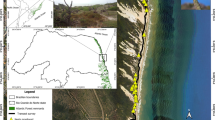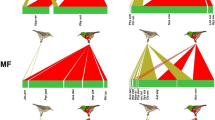Abstract
The mean vigilance of animals in a group often decreases as their group size increases, yet nothing is known about whether there is individual variability in this relationship in species that change group sizes frequently, such as those that exhibit fission–fusion social systems. We investigated variability in the relationship between group size and vigilance in the eastern grey kangaroo (Macropus giganteus) by testing whether all individuals showed decreased vigilance with increased group size, as has been commonly assumed. We carried out both behavioural observations of entire groups of kangaroos and focal observations of individually recognised wild female kangaroos. As in other studies, we found a collective group-size effect on vigilance; however, individuals varied in their vigilance patterns. The majority (57%) of the identified individual kangaroos did not show significant group-size effects for any of the recorded measures of vigilance. The females that did not show a negative group-size effect were, on average, more vigilant than those females that did show a group-size effect, but this difference was not significant. We propose that some females exhibit higher levels of social vigilance than others, and that this social vigilance increases with group size, cancelling out any group-size effect on anti-predator vigilance for those females. Our results therefore suggest that only some prey individuals may gain anti-predator benefits by reducing their time spent scanning when in larger groups. The large amount of variation that we found in the vigilance behaviour of individual kangaroos highlights the importance of collecting and analysing vigilance data at the individual level, which requires individual recognition.


Similar content being viewed by others
References
Banks PB (2001) Predation-sensitive grouping and habitat use by eastern grey kangaroos: a field study. Anim Behav 61:1013–1021
Banks PB, Newsome AE, Dickman CR (2000) Predation by red foxes limits recruitment in populations of eastern grey kangaroos. Austral Ecol 25:283–291
Bednekoff PA, Lima SL (1998) Randomness, chaos and confusion in the study of antipredator vigilance. Trends in Ecol Evol 13:284–287
Bednekoff PA, Lima SL (2002) Why are scanning patterns so variable? An overlooked question in the study of anti-predator vigilance. J Avian Biol 33:143–149
Blanchard P, Fritz H (2007) Induced or routine vigilance while foraging. Oikos 116:1603–1608
Blumstein DT, Evans CS, Daniel JC (1999) An experimental study of behavioural group size effects in tammar wallabies, Macropus eugenii. Anim Behav 58:351–360
Blumstein DT, Daniel JC, McLean IG (2001) Yellow-footed rock-wallaby group size effects reflect a trade-off. Ethology 107:655–664
Burger J, Gochfeld M (1992) Effect of group size on vigilance while drinking in the coati, Nasua narica, in Costa Rica. Anim Behav 44:1053–1067
Burger J, Gochfeld M (1994) Vigilance in African mammals: differences among mothers, other females and males. Behavior 131:153–169
Cameron EZ, du Toit JT (2005) Social influences on vigilance behaviour in giraffes, Giraffa camelopardalis. Anim Behav 69:1337–1344
Carere C, Eens M (2005) Unravelling animal personalities: how and why individuals consistently differ. Behavior 142:1149–1157
Carter AJ, Macdonald SL, Thompson V, Goldizen AW (2009) Structured association patterns and their energetic benefits in female eastern grey kangaroos. Macropus giganteus. Anim Behav. doi:10.1016/j.anbehav.2008.12.007
Childress MJ, Lung MA (2003) Predation risk, gender and the group size effect: does elk vigilance depend upon the behaviour of conspecifics? Anim Behav 66:389–398
Clarke JL, Jones ME, Jarman PJ (1989) A day in the life of a kangaroo: activities and movements of eastern grey kangaroos Macropus giganteus at Wallaby Creek. In: Grigg G, Jarman PJ, Hume I (eds) Kangaroos, wallabies and rat-kangaroos. Surrey Beatty, Chipping Norton, pp 611–618
Clarke JL, Jones ME, Jarman PJ (1995) Diurnal and nocturnal groupings and foraging behaviours of free-ranging eastern grey kangaroos. Aust J Zool 43:519–529
Colagross AMC, Cockburn A (1993) Vigilance and grouping in the eastern grey kangaroo (Macropus giganteus). Aust J Zool 41:325–334
Di Blanco Y, Hirsch BT (2006) Determinants of vigilance behaviour in the ring-tailed coati (Nasua nasua): the importance of within-group spatial position. Behav Ecol Sociobiol 61:173–182
Elgar MA (1989) Predator vigilance and group size in mammals and birds: a critical review of the empirical evidence. Biol Rev Camb Phil Soc 64:13–33
Fernandez-Juricic E, Beauchamp G, Bastain B (2007) Group-size and distance-to-neighbour effects on feeding and vigilance in brown-headed cowbirds. Anim Behav 73:771–778
Frid A (1997) Vigilance by female Dall's sheep: interactions between predation risk factors. Anim Behav 53:799–808
Goldsmith AE (1990) Vigilance behaviour of pronghorns in different habitats. J Mammal 71:460–462
Grant TR (1973) Dominance and association among members of a captive and free-ranging group of grey kangaroos (Macropus giganteus). Anim Behav 21:449–456
Hunter TB, Skinner JD (1998) Vigilance behavior in African ungulates: the role of predation pressure. Behav 135:195–211
Illius AW, FitzGibbon C (1994) Costs of vigilance in foraging ungulates. Anim Behav 47:481–484
Jarman PJ (1987) Group size and activity in eastern grey kangaroos. Anim Behav 35:1044–1050
Jarman PJ, Southwell CJ (1986) Grouping, associations and reproductive strategies in eastern grey kangaroos. In: Rubenstein DI, Wrangham RW (eds) Ecological aspects of social evolution: birds and mammals. Princeton University Press, Princeton, New Jersey, pp 399–428
Jarman PJ, Jones ME, Johnson CN, Southwell CJ, Stuart-Dick RI, Higginbottom KB, Clarke JL (1989) Macropod studies at wallaby creek: VIII. Individual recognition of kangaroos and wallabies. Aust Wildl Res 16:179–185
Klose SM, Welbergen JA, Goldizen AW, Kalko EKV (2009) Spatio-temporal vigilance architecture of an Australian flying-fox colony. Behav Ecol Sociobiol 63:371–380
Kutsukake N (2006) The context and quality of social relationships affect vigilance behavior in wild chimpanzees. Ethol 112:581–591
Laundré JW, Hernandez L, Altendorf KA (2001) Wolves, elk, and bison: reestablishing the "landscape of fear" in Yellowstone National Park, USA. Can J Zool 79:1401–1409
Lima SL (1990) Protective cover and the use of space: different strategies in finches. Oikos 58:151–158
Lima SL (1995) Back to the basics of anti-predatory vigilance: the group-size effect. Anim Behav 49:11–20
Lopez P, Hawlena D, Polo V, Amo L, Martin J (2005) Sources of individual shy-bold variations in antipredator behaviour of male Iberian rock lizards. Anim Behav 69:1–9
Lung MA, Childress MJ (2006) The influence of conspecifics and predation risk on the vigilance of elk (Cervus elaphus) in Yellowstone National Park. Behav Ecol 18:12–20
Mather JA, Anderson RC (1993) Personalities of octopuses (Octopus rubescens). J Comp Psychol 107:336–340
Matson TK, Goldizen AW, Putland DA (2005) Factors affecting the vigilance and flight behaviour of impalas. S Afr J Wildl Res 35:1–11
Pays O, Jarman PJ (2008) Does sex affect both individual and collective vigilance in social mammalian herbivores: the case of the eastern grey kangaroo? Behav Ecol Sociobiol 62:757–767
Pays O, Jarman PJ, Loisel P, Gerard J-F (2007a) Coordination, independence or synchronization of individual vigilance in the eastern grey kangaroo? Anim Behav 73:595–604
Pays O, Renaud P-C, Loisel P, Petit M, Gerard J-F, Jarman PJ (2007b) Prey synchronize their vigilant behaviour with other group members. Proc R Soc Lond B 274:1287–1291
Poole WE, Carpenter SM, Wood JT (2002) Growth of grey kangaroos and thereliability of age determination from body measurements. I. The eastern grey kangaroo, Macropus giganteus. Aust Wildl Res 9:9–20
Pulliam HR (1973) On the advantages of flocking. J Theor Biol 38:419–422
Quenette P-Y (1990) Functions of vigilance in mammals: a review. Acta Oecol 11:801–818
Reale D, Reader SM, Sol D, McDougall PT, Dingemanse NJ (2007) Integrating animal temperament within ecology and evolution. Biol Rev 82:291–318
Roberts G (1996) Why individual vigilance declines as group size increases. Anim Behav 51:1077–1086
Robinette RL, Ha JC (2001) Social and ecological factors influencing vigilance by northwestern crows, Corvus caurinus. Anim Behav 62:447–452
Sih A, Bell A, Johnson JC (2004) Behavioral syndromes: an ecological and evolutionary overview. Trends Ecol Evol 19:372–378
Southwell CJ (1984a) Variability in grouping of the eastern grey kangaroo, Macropus giganteus I: Group density and group size. Aust Wildl Res 11:423–435
Southwell CJ (1984b) Variability in grouping of the eastern grey kangaroo, Macropus giganteus II: Dynamics of group formation. Aust Wildl Res 11:437–449
Treves A (2000) Theory and method in studies of vigilance and aggregation. Anim Behav 60:711–722
Underwood R (1982) Vigilance behavior in grazing African antelope. Behavior 79:81–107
Acknowledgements
We would like to express our thanks to Brian Mays and the rest of the staff at Elanda Point, who allowed us to study kangaroos at Elanda Point and provided logistical support, and to the National Geographic Society, who funded the work. We also thank two anonymous reviewers for comments on an earlier version of this paper. This research was approved by the University of Queensland’s Animal Experimentation Ethics Committee and carried out under a Scientific Purposes Permit from Queensland’s Environmental Protection Agency.
Author information
Authors and Affiliations
Corresponding author
Additional information
Communicated by P. Banks
Rights and permissions
About this article
Cite this article
Carter, A.J., Pays, O. & Goldizen, A.W. Individual variation in the relationship between vigilance and group size in eastern grey kangaroos. Behav Ecol Sociobiol 64, 237–245 (2009). https://doi.org/10.1007/s00265-009-0840-4
Received:
Revised:
Accepted:
Published:
Issue Date:
DOI: https://doi.org/10.1007/s00265-009-0840-4




